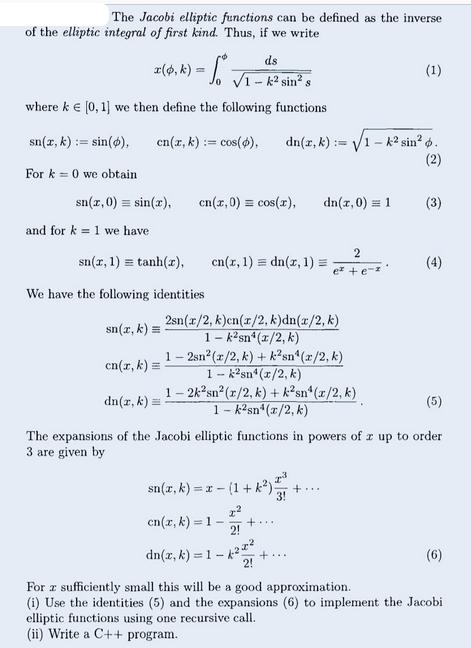Answered step by step
Verified Expert Solution
Question
1 Approved Answer
The Jacobi elliptic functions can be defined as the inverse of the elliptic integral of first kind. Thus, if we write ds x(0, k)

The Jacobi elliptic functions can be defined as the inverse of the elliptic integral of first kind. Thus, if we write ds x(0, k) = 1-k sin s where k = [0,1] we then define the following functions (1) sn(x, k)=sin(), cn(x,k) := cos(0). dn(x, k)=1 k sin. - (2) For k 0 we obtain. sn(x, 0)=sin(x), cn(x, 0) = cos(x), dn(z,0) = 1 (3) and for k 1 we have. 2 sn(2,1) = tanh(r), cn(x, 1) dn(x, 1) = (4) e + e-z We have the following identities sn(x, k) = 2sn(x/2, k)cn(r/2, k)dn(x/2, k) 1- ksn (x/2, k) 1-2sn2(x/2, k) + ksn (x/2, k) cn(x, k) = 1-k2sn(x/2, k) dn(x, k) = 1-2k2sn(r/2, k) + ksn(x/2, k) 1-k2sn(x/2, k) (5) The expansions of the Jacobi elliptic functions in powers of r up to order 3 are given by sn(x, k) = =x-(1+k). +... cn(x, k) 1- +... 2! dn(x, k) = 1-4+... 2! For a sufficiently small this will be a good approximation. (6) (i) Use the identities (5) and the expansions (6) to implement the Jacobi elliptic functions using one recursive call. (ii) Write a C++ program.
Step by Step Solution
★★★★★
3.40 Rating (150 Votes )
There are 3 Steps involved in it
Step: 1
To implement the Jacobi elliptic functions using one recursive call we can use the identities 5 and ...
Get Instant Access to Expert-Tailored Solutions
See step-by-step solutions with expert insights and AI powered tools for academic success
Step: 2

Step: 3

Ace Your Homework with AI
Get the answers you need in no time with our AI-driven, step-by-step assistance
Get Started


